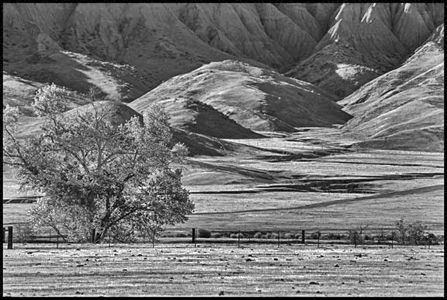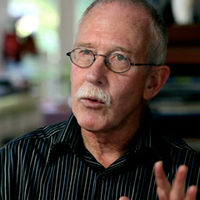
Interstate 5, running down the west side of the San Joaquin Valley, California cuts a dividing line between the flat valley floor and dry hills rising to the west. Passengers in thousands of cars and trucks, seemingly desperate to pass by as quickly as possible on the highway to Los Angeles, can look east over a landscape of huge fields and orchards. On a clear day, when the wind sweeps away the valley’s omnipresent dust, you can see the Sierras.
To the west, though, the land is hidden behind a succession of eroded ridges. Beyond them rises the strange, sere landscape of the Panoche and Griswold Hills.
Today California is dry, in the throes of a four-year drought. Even in more “normal” times in the past, however, these hills were as dry as the rest of the state is now. You can feel it, reaching down and crumbling the soil in your hands. It is a dryness that perhaps predicts what we will soon see elsewhere.
This is grazing land. Narrow blacktop roads snake up from the valley floor past old barns and fences. The cattle have worn grooves and paths that meander horizontally across worn hillsides. Some are covered in stubble, while others have no remnants of grass at all. Then, cutting down across their face are the old watercourses. Now they’re dry, but their dramatic vertical sides testify to the power of the flash floods that, in a rare heavy rain, carry away the rocks and thin soil.
The San Joaquin Valley floor to the east is largely made up of the sediment washed down Panoche Creek and its tributaries. On the creek bottom, trees and a few isolated homes are patches of green in a brown vista that stretches for miles. But everything here speaks of the lack of water.
A small field of grapevines or berries, now dry, is a memory of some effort to seek out an income beyond a ranch’s animals. A fence line stretches up into hills bleached blindingly white. Another fence, like those in Mexico’s Sonora desert, is a barrier made of thin dry cactus branches tied together. The sky’s bright light shines through rusted bullet holes in an ancient empty water tower.
The ranches here are small. But a century ago the cattle on this land belonged to Henry Miller, one of California’s original cattle kings. He got it from Daniel Hernandez whose title stretched back to an original 22,000-acre land grant. In 1844 Mexican governor Manuel Micheltorena awarded these hills to Julian Ursua and Pedro Romero, just before California was taken by the United States in the Treaty of Guadalupe Hidalgo in 1848.
Before that, it was the land on which Northern Yokuts were living. They had not yet discovered the joys of private ownership, however, and when the recently canonized Father Junipero Serra arrived to set up missions, they were in the way. They also made a ready source of labor. The Yokuts were driven from these hills, and forced into servitude in the Missions of San Jose, Soledad, and San Antonio. In the closest, Mission San Juan Bautista, the graves of these Indigenous inhabitants lie in the shadows of the church’s thick, whitewashed adobe walls.
The Yokuts, or perhaps others who came before them, were the first human arrivals in this landscape. If they came as early as 12,000 years ago, they might have seen the final retreating glaciers of the last ice age. The icecap ended about here, in San Benito County. In the floods and storms that followed as the climate warmed, whole mountains were washed into the valley below, creating the soil that now feeds the world.
The Panoche and Griswold Hills are what remained. They are the bones of an ancient landscape. In the Cretaceous period, 65 million years ago, most of California was underwater. Only the highest mountains of the present Coast Range then poked above the waves as islands. The bottom of this inland sea became the graveyard of water-borne Mosasaurs and Plesiosaurs, along with smaller dinosaurs and the ancestors of today’s turtles. Sandstone is the first layer of rock under the thin soil of these hills, and then, under that, the Moreno Shale holds their bones.
The runoff from eons of erosion concentrated the minerals leached from the rocks. Selenium especially washed into Panoche Creek, and from there, into the San Joaquin Valley below. It seeped into the land watered by the creek and others like it, throughout the northern part of the Westlands. After World War II, huge canals and irrigation projects were engineered to bring water to the valley’s west side, for the benefit of big landowners. But irrigating land with this history had disastrous consequences.
Selenium, boron and other salts rose into the wastewater runoff from irrigation. Growers built subterranean drains to pump the water away, dumping it into the vernal ponds of the Kesterson wildlife refuge. Selenium then caused migratory birds, on one of the world’s main flyways, to lay eggs with shells so thin they were crushed in their nests. The drain was closed, but agriculture on the Westside goes on as before.
Above the flat valley the Panoche and Griswold Hills themselves became home to endangered animals, including giant kangaroo rats, San Joaquin kit foxes and blunt-nosed leopard lizards. Ironically, grazing helps to keep them going, according to Mike Westphal, a biologist for the Bureau of Land Management. “They only live where the land is bare,” he told Sarah Phelan of the Bay Nature. “People used to think this land was being overgrazed, but it’s bare because it can’t support anything. If we keep with the ranches, endangered species and the ranches win.”
The land is now in the sight of the fracking industry. In 2012 BLM auctioned off leases for oil exploration in the Monterey Shale, which extends into the Panoche and Griswold Hills. Other dangers come from possible solar array projects.
Yet this is a landscape that has always been in danger. It is not the lush environment of the coast, with its fog and forests. Survival of the land itself and the animals, plants and people on it seems to have been precarious throughout its history.
It is austere. It is dry. It is dramatically beautiful.
The Reality Check. Stories and photographs by David Bacon.

MOST POPULAR TODAY

High Court essentially bans demonstrations, freedom of assembly in Deep South

UN warns that Israel is still blocking humanitarian aid to Gaza

Resource wars rage in eastern Congo, but U.S. capitalism only sees investment opportunity

U.S. imperialism’s ‘ironclad’ support for Israel increases fascist danger at home







Comments